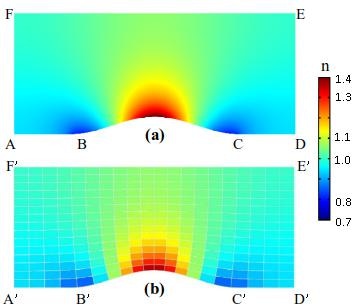Apr 22 2019
The invisible device, acoustic carpet cloak, has the ability to mask objects on a reflecting surface. In other words, an acoustic beam will not be able to detect the object wearing the carpet cloak.
 Profile of (a) the continuous refractive index and (b) the discrete approximation in the acoustic carpet. (Image credit: IOA)
Profile of (a) the continuous refractive index and (b) the discrete approximation in the acoustic carpet. (Image credit: IOA)
Therefore, the acoustic carpet cloak has a vital role to play in the applications of acoustic communication and detection.
However, the linear transformation technique, which was recommended in 2008, leads to massive anisotropic parameters, rendering the carpet cloak hard to go with the background medium separately and also restricting the shape of the cloaked space.
The biggest difficulty of an underwater acoustic carpet cloak is impedance matching. Hence, to overcome this issue, researcher YANG Jun and his group from the Institute of Acoustics (IOA) of the Chinese Academy of Sciences successfully created an underwater acoustic carpet cloak using penta-mode meta-fluid material—a type of solid structure that has fluid-like acoustic property in which the longitudinal wave alone can exist.
The investigators hypothetically measured the carpet cloak’s parameters, and created the unit cells with effective parameters that were sufficiently close to theoretical values. Aluminum was selected as the substrate of the unit cells, and to obtain the cloak structure, the unit cells were assembled following quasi-conformal transformation (QCT).
The designed carpet cloak, composed of aluminum hexagons, effectively achieved impedance matching with water. The band’s unit cells were below one-tenth of the wavelength in water, allowing it to work even in the deep sub-wavelength scale.
During the simulation, the cases of rigid scatter, penta-mode carpet cloak, and rigid plane were examined. With regards to the rigid scatter case, the rigid bump on the plane scattered the incident beam so that the aspect of the scattered waves can be seen. The waves that were reflected by the carpet cloak was able to retain a high similarity as that of the rigid plane, suggesting that the designed penta-mode carpet cloak can appropriately mask the object.
In addition, simulation outcomes demonstrated that the proposed acoustic carpet cloak exhibited excellent performance in a broad frequency range.
The study has promising application values in underwater acoustic detection. The deformation technique may also provide a better understanding on the design of randomly-shaped devices.
The study, reported in Applied Physics Letters, was supported by the National Natural Science Foundation of China, the IACAS Young Elite Researcher Project, and the Youth Innovation Promotion Association CAS.